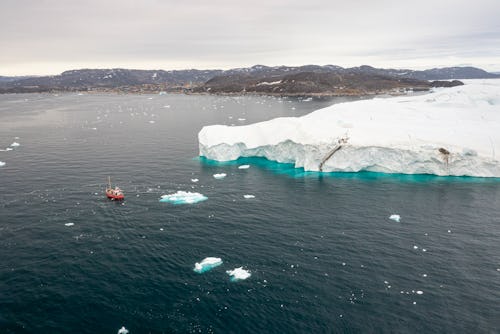“Zombie ice” near Greenland is a catastrophe waiting to happen
The giant ice sheets are doomed to melt — bringing with them devastating sea level rise.

Who knew the zombie apocalypse would actually be the climate crisis? A new study in the journal Nature Climate Change warns that the undead that we should be worried about are not walking corpses, but actually floating blocks of ice that will inevitably melt. These “dead” sheets of ice, found largely off the coast of Greenland, possess the potential to raise sea levels by as much as 10.6 inches by the end of this century.
Let’s take a step back real quick and explain what zombie ice is, lest you be given the wrong idea that it can bite other glaciers and turn them, or something. “Zombie ice” refers to ice that is still attached to thicker glaciers, but is no longer receiving the snow it needs to replenish itself. Because it’s not getting the insulation of snow to protect or preserve it, the ice is basically doomed to “die,” or melt. Hence, zombie ice. It’s the walking dead of the Arctic, along with zombie fires that have also cropped up in the region in recent years, too.
As for why zombie ice is worth worrying about: Well, much like the traditional undead horde, it could overwhelm us. According to new research, the melting ice sheets near Greenland are likely to raise our sea levels by more than 10 inches. That’s basically locked in, according to the study — and things could get much, much worse than that. The worst-case scenario projects a sea level rise of up to 30 inches.
This is significantly more than previous predictions saw coming. The 10 inches is about double the amount that the most recent Intergovernmental Panel on Climate Change warned of when it projected between 2 to 5 inches of sea levels rising by 2100 due to the melting ice near Greenland. The projected 10-inch lift would push the baseline for ocean levels to the height typically achieved during high tides and storms. Basically, we’ll be sitting at the levels that normally lead to inland flooding — and we’ll be staring down more extreme weather and storms, likely to generate even more destruction to coastlines because of it.
The reason for this dramatic increase in the projected water levels rising is a new understanding of just how much ice is going to be lost in the coming years. The study found that about 3.3% of Greenland’s total ice volume is going to melt no matter what we do to cut back on our carbon emissions. That loss is locked in, meaning about 120 trillion tons of ice is doomed to disappear in the coming years.
The result is a 10-inch water level rise by 2100, and that’s basically the best-case scenario. If we fail to cut down on our carbon emissions, we could see three times that amount of rising sea levels. It might be zombie ice, but if we’re not careful, we might be the walking dead.